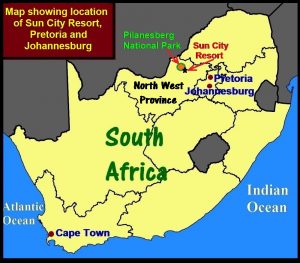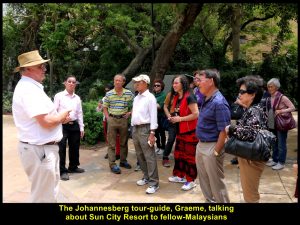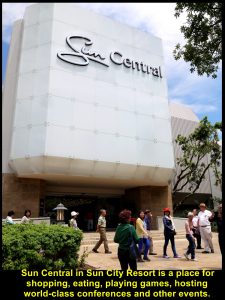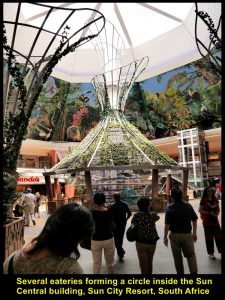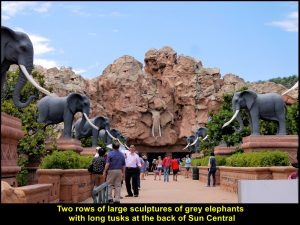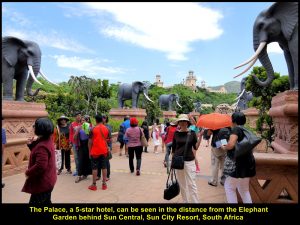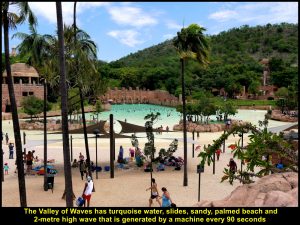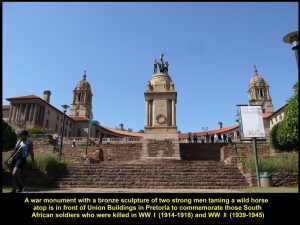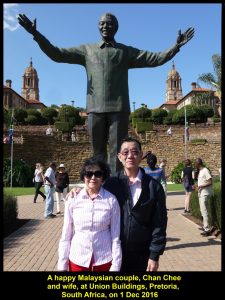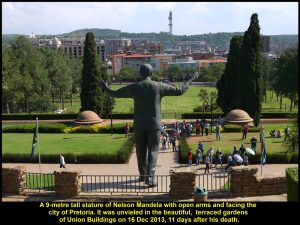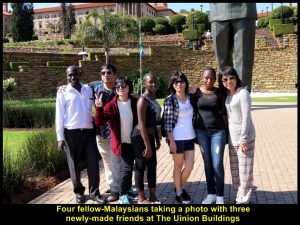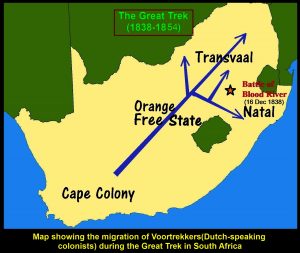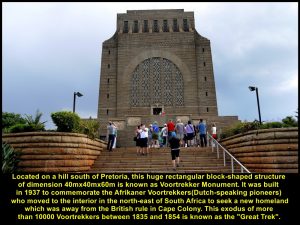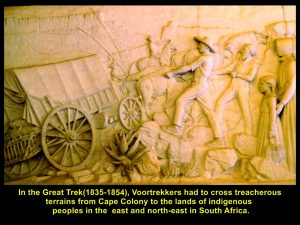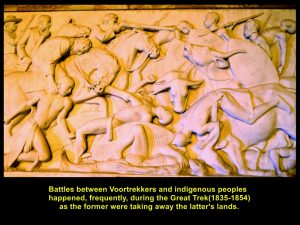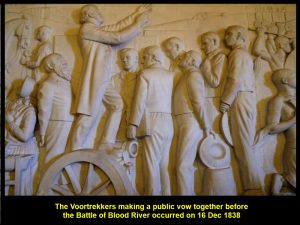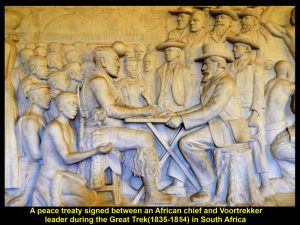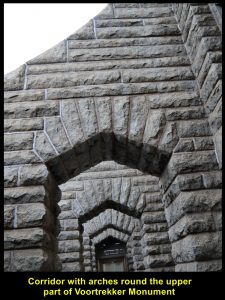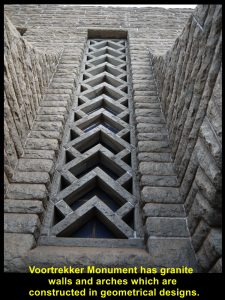South Africa Travel Part VI : Sun City Resort, Union Buildings, Voortrekker Monument
Filed under: South Africa Travel Part VI : Sun City, Union Buildings, Voortrekker Monument
South Africa Travel Part VI : Sun City Resort, Union Buildings, Voortrekker Monument
(Continue from South Africa Travel Part V)
Day 6 Thursday, 1 Dec 2016
Sun City Resort
After a game-drive(safari) in the morning in Pilanesberg National Park, we went to Sun City Resort located in a hilly area near the park.
Sun City Resort has four hotels with casinos ranging from 3 to 5 stars, world-class golf courses, a theme- park, a shopping centre, an artificial, sandy beach with palm-trees, two-metre high artificial waves, and many more.
The Palace
On arrival at the resort, we had a glimpse of the 5-star hotel, The Palace, which looked like ancient Arabian buildings we see in Aladdin’s movies.
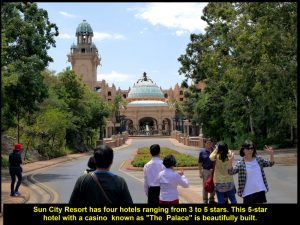
The Palace, a 5-star hotel with casino, in Sun City Resort, near Pilanesberg Natural Park, South Africa
Sun Central
Then we went to another building nearby, Sun Central, where visitors could shop. dine and play games. This building has hosted world-class conferences, national and world beauty-pageants, and other activities.
Elephant Statues
At the back of Sun Central, we saw sculptures of two rows of life-sized, grey elephants with long tusks. The place looked like an elephant garden.
Valley of Waves
There was an artificial sea and sandy beach with palm-trees in the Valley of Waves which was further away from the garden. Every 90 seconds, a two-metre high wave was created in the sea sending the swimmers to the beach.
Union Buildings
We spent a short time at the resort and then travelled for two hours to Pretoria. When we reached the city, we went to the top of a hill, Meintjieskop where an important building was sited, Union Buildings. Built in neoclassical Italian renaissance architectural style in 1910 and completed in 1913, it is the seat of the government of South Africa and houses the President’s offices.
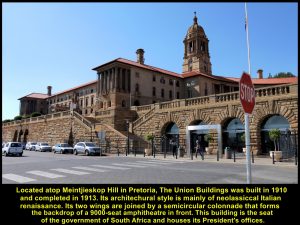
Union Buildings, built in 1910, is the seat of the government of South Africa and houses the President’s offices in Pretoria.
War Monument
Across the road in front of Union Buildings is a large, tall, cylindrical shaped structure with a bronze sculpture of two strong men taming a wild horse atop. It is erected there in memory of the South African soldiers who were killed in WW I(1914-1918) and WW II(1939-1945).
Statue of Nelson Mandela
There are terraced, manicured gardens down the slope where a large, tall statue stands. It is the statue of the first elected President of South Africa, Nelson Mandela(1918-2013) unveiled on 16 Dec 2013, 11 days after his death. He held the office from 1994 until 1999.
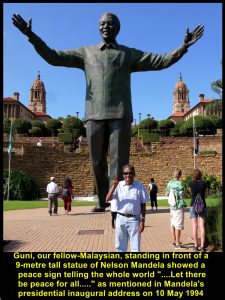
Guni, fellow-Malaysian, standing with a V-sign in front of a 9-metre tall statue of Nelson Mandela at Union Buildings, Pretoria
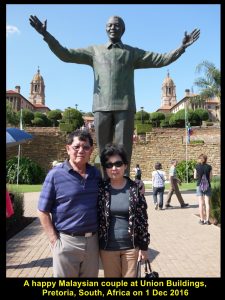
A fellow-Malaysian couple standing in front of the tall statue of Nelson Mandela at Union Buildings, Pretoria
City of Pretoria
The statue of Nelson Mandela standing tall with open arms in the terraced garden on a slope in front of Union Buildings is facing the city of Pretoria in the distance and the scenery is picturesque.
New Friends
In the garden I was surprised to see three of our fellow-Malaysians make friends with strangers, easily, and they took a photo with them, too.
We spent an hour at Union Buildings keeping our cameras and phone-cameras busy.
Voortrekker Monument
Soon we left Union Buildings and went to a historic monument known as Voortrekker Monument located on a hill that is south of the city of Pretoria.
The Great Trek(1835-1854)
Voortrekker Monument was erected in memory of more the 10000 Voortrekkers(Dutch-speaking pioneers) who trekked across treacherous terrains from Cape Colony to the interior inhabited by unfriendly indigenous peoples in north-east of South Africa. They were in search of a homeland that was fertile for farming and free from the British rule. The exodus known as the Great Trek occurred between 1835 and 1854.
Hall of Heroes
There are two halls in the monument, Hall of Heroes and Hall of Cenotaph. Fixed on the walls in the Hall of Heroes in the monument is a long frieze with 27 panels depicting the exodus of the Voortrekkers in the Great Trek, battles fought and treaties signed between the Voortrekkers and indigenous peoples, etc.
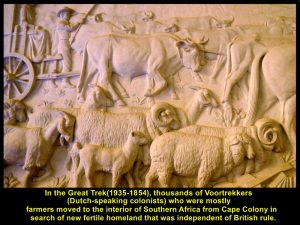
Over 10000 Voortrekkers, mostly farmers, moved to the interior in South Africa in search of new homeland free from the British rule in Cape Colony.
Battle of Blood River(1838)
The Voortrekkers in the Great Trek encountered many battles with the indigenous peoples resulting in many casualties. The well-known battle in the Great Trek was the Battle of Blood River that happened on 16 Dec 1838. It was fought between 470 Voortrekkers and between 15000 and 21000 Zulu attackers on the bank of Ncome River on 16 Dec 1838 resulting in 3000 Zulu casualties and 3 wounded Voortrekker commandos. The battle was won by the Voortrekkers.
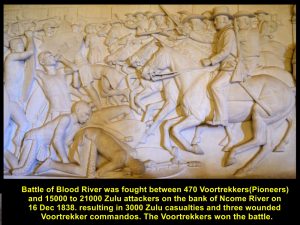
Historical Battle of Blood River on 16 Dec 1838 between 15000-21000 Zulu attackers and 470 Voortrekkers
The Vow
Before the Battle of Blood River on 16 Dec 1838, the Voortrekker men made a public vow together. A tablet in the compound of Voortrekker Monument carries the inscription of The Vow.
The Voortrekkers vowed to God that if He helped them to win the war, they would make that day like a holy Sabbath and build a house to worship Him. Besides, they would tell their future generations to glorify and honour Him.
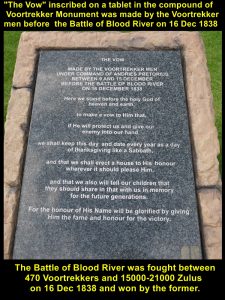
The Vow was made by the Voortrekker men before the Battle of Blood River was fought on 16 Dec 1838.
Treaties
After some battles, peace treaties were signed between the indigenous chiefs and Voortrekker leaders.
Hall of Cenotaph
In the Hall of Cenotaph which is below the Hall of Heroes, there is a cenotaph in the centre with an inscription in Afrikaans, “ONS VIR JOU SUID AFRIKA”(“We for thee, South Africa”). On 16 December every year, sunlight passes through a round glass-dome in the ceiling in Hall of Heroes and the dome focuses the light onto the words on the cenotaph at noon. The date has to do with that of the Voortrekkers’ victorious Battle of Blood River which was fought on 16 Dec 1838.
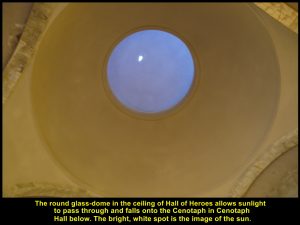
The glass dome focuses the sunlight onto the words on the cenotaph below at noon on 16 Dec every year. The white spot in the dome is the image of the sun.
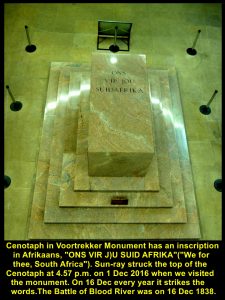
A focused sunlight strikes the top of the Cenotaph at 4.57 p.m. on 1 Dec 2916 when I was there, in Voortrekker Monument.
Voortrekker Woman
A bronze sculpture of a woman with her two children is erected at the base of Voortrekker Monument in recognition of the contributions, perseverance, courage and sacrifices of the Voortrekker women during the Great Trek(1835-1854).
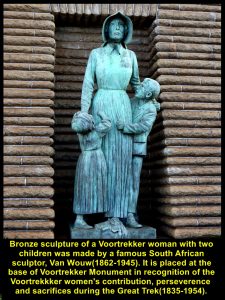
A scuplture of a Voortrekker woman and her children erected at the base of Voortrekker Monument in recognition of the contributions, perseverance and sacrifices of the Voortrekker women during the Great Trek(1835-1854)
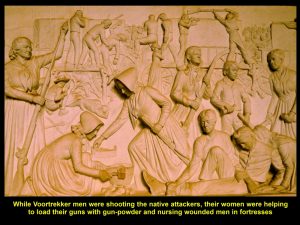
Voortrekker women helped men to load gun-powder and nursed the wounded during the battles against the natives.
Top of Voortrekker Monument
In the Hall of Heroes, we took a lift to the top of the monument which was more than 40 metres high. In the corridor of the monument top, the arches and walls were built in geometrical designs. Looking from the top, we could see a breathtaking view of the city of Pretoria and its surroundings.
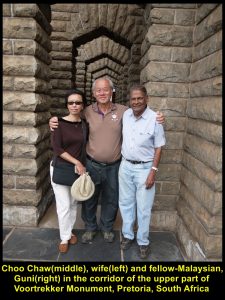
Choo Chaw(middle), wife(left) and Guni(right, a fellow-Malaysian) in the corridor of the top of Voortrekker Monument on 1 Dec 2016
Voortrekkers’ Wagons
Before we left Voortrekker Monument, I saw a wagon near the bottom of the steps of the monument. It was a replica of the ox-drawn wagons used in the Great Trek(1835-1854). Besides transporting heavy things, those wagons were arranged in a circle or laager as a defence against surprise attacks from the indigenous peoples in the interior of South Africa.
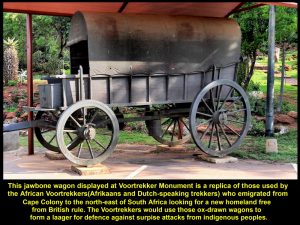
Voortrekkers used this kind of wagon to carry heavy things and arranged many of them in a circle as a defence against surprise attacks in the interior of South Africa.
We left Voortrekker Monument at 5.20 p.m. after spending an hour there. We have learned a lot about the history of Voortrekkers at the monument.
We would visit three more places, Kruger Museum, Church Square and Melrose House, before we had dinner at Carnivore Restaurant.
(continue in South Africa Travel Part VII)
Written by Choo Chaw
South Africa Travel Part I: Air Flight from KLIA to Cape Town, Cape Town Shantytowns
South Africa Travel Part II: Table Mountain, Malay Quarter, Castle of Good Hope. A & V Waterfront
South Africa Travel Part III: Hermanus, Cheetah Outreach, Stellenbosch, Jewel Africa
South Africa Travel Part V: Pilanesberg National Park(Game Drives)
South Africa Travel Part VI: Sun City Resort, Union Buildings, Vootrekker Monument,
South Africa Travel Part VII Kruger Museum, Church Square, Melrose House, Carnivore Restaurant
South Africa Travel Final Part Gold Reef City: Gold Mine Museum

